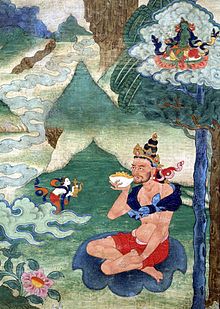Naropa
Naropa (also: naropa , Naro or Nārotapa ; Tib. ནཱ་ རོ་ པ་, Wylie . NA ro pa * 1016 ; † 1100 ) was a Buddhist master and one of the 84 Mahasiddhas .
biography
He was born in northeast India or Bengal and grew up in a noble family. His upbringing was aimed at taking over the throne and title of his father, but also included instructions on Buddhist teachings and the teachings of the Brahmins . At the age of eight he expressed the desire to study. At his request, he was allowed to go to Kashmir to study when he was eleven years old . According to some sources, his travel time alone should have taken three years. Other sources state that his studies in Kashmir were said to have lasted three years and that he then returned home and continued his studies at home until he was married to the Brahmin daughter Vimaladipi in 1032 AD at the age of 16. The marriage lasted eight years, then he broke the bond and went back to Kashmir. He ordained and resumed his studies.
At the age of 28 he moved to Pullahari near Nalanda (Northern India). There, in the first Buddhist university with a large number of scholars and students, he received further teachings and became abbot of the university himself.
One day he met an old woman who is said to be the embodiment of the Dakini Vajravarahi . She made it clear to Naropa the importance of the practical experience of meditation and advised him to see Master Tilopa .
Nāropa then left Nalanda and the Buddhist order and went to Tilopa, whom he met after a long search in eastern India. Tilopa gave Nāropa severe training in order to develop his mind so that he would be ready for enlightenment . With practical exercises he trained his concentration, his strength of mind and his acuity of mind - three pillars of the mind to master the final realization. At the same time, he was given oral initiations to secret teachings. Both in the twelve years that it took Nāropa to find Tilopa, and in the twelve years that followed, in which he accompanied Tilopa, he was faced with tasks that took him from a purely intellectual understanding of Buddhist teachings to an inner deep understanding of the Nature of the mind and application of the teachings.
Nāropa finally achieved enlightenment in a very unconventional way when one day he asked his teacher for further instruction and instead was hit on the head with Tilopa's shoe. As a result, the last veils fell from Naropa's mind and he realized mahamudra . He then spent 21 years in Pulahari teaching the Dharma .
The Six Yogas of Nāropa
He summarized the most important transmissions that he had received from Tilopa in six forms of meditation. They are known to this day under the name Six Yogas of Nāropa . They are viewed as a “higher practice” and therefore generally only given in their entirety to a few, more experienced students of Buddhist teachers, as their effect on the mind is said to be very strong.
Nāropa passed the transmission for these forms of meditation on to his student Marpa , the translator, among others . Another important student of Nāropa was Niguma , who is usually spoken of as his tantric companion, sometimes as his sister (which is due to the fact that the Tibetan term cham mo is not clear here and the companion is special for the Shangpa Kagyu school Meaning is).
swell
- Herbert V. Guenther : The Life and Teachings of Nāropa . Shambhala Publishing, Boston 1986, ISBN 1-56957-110-4
- Keith Dowman: The Masters of Mahamudra . Diederichs-Verlag, Munich 1991, ISBN 3-424-01076-6 , p. 182 ff.
Web links
- Khenpo Chödrak Tenphel Rinpoche: Naropa - His Life
- Literature by and about Naḍapāda in the catalog of the German National Library
| personal data | |
|---|---|
| SURNAME | Naropa |
| ALTERNATIVE NAMES | Nāropa; Nāro; Nārotapa; na ro pa (Tibetan) |
| BRIEF DESCRIPTION | Buddhist clergyman |
| DATE OF BIRTH | 1016 |
| DATE OF DEATH | 1100 |
